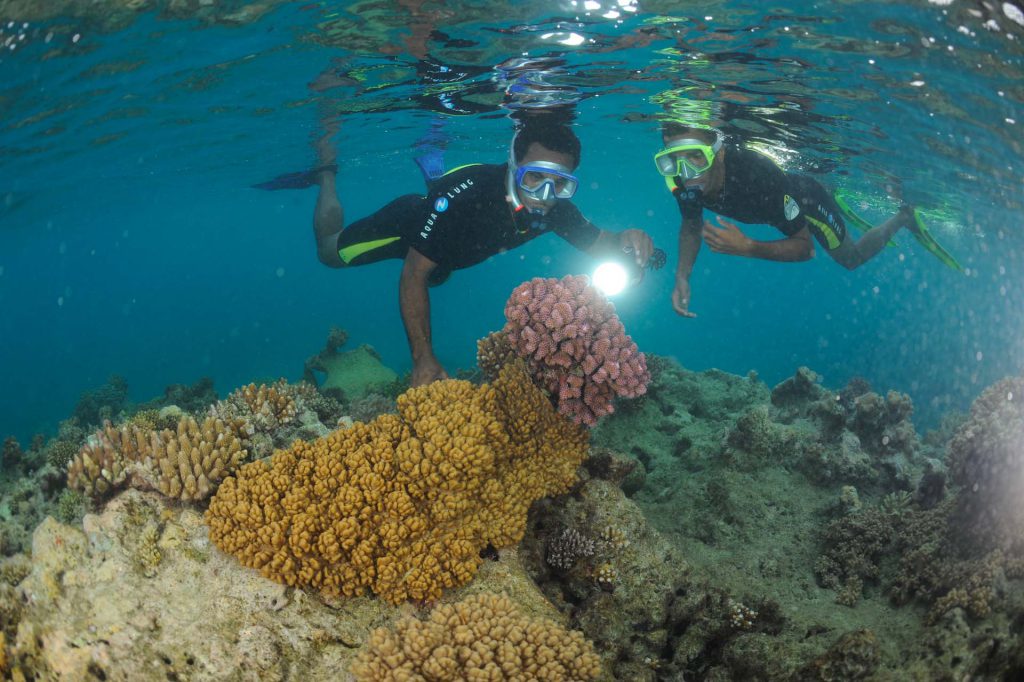Snorkelling around the Yeega islet
The underwater and botanic trails of the Yeega islet were set up to enable visitors to discover the multiple fish, coral and plant species of this Protected Marine Area (PMA).
Located some 15 minutes by boat off the coast where dwell the Koulnoue and Linderalique tribes, the Yeega islet offers the ideal conditions to experience the joys of snorkelling. The islet is easily accessible and protected from dominant winds and the influence of waterways and their sediments. It is located in the heart of the World Heritage area and regroups a number of different marine ecosystems. ‘The Yeega trail boasts a remarkable biodiversity with a sandy area, an underwater meadow as well as soft and hard corals,’ points out Sébastien Faninoz, who set up the trail is the WWF coordinator for the Protected Marine Areas in the North-East. ‘The 250-metre-long trail enables a safe dive in crystal-clear and shallow waters at 2 to 5 metres deep,’ adds this biology teacher, who also set up the highly popular Duck Island underwater trail off the coast of Noumea in 2001.
A perfect activity to discover a remarkable biodiversity with a sandy area, an underwater meadow as well as soft and hard corals
Snorkellers only have to follow the Babou Plongée dive centre guides who will provide them with ample explanation on the species that can be found along the way, their habitat and behaviour. The snorkellers go back and forth between the surface and the bottom and between the 5 numbered buoys that allow the discovery of the different ecosystems. ‘This tourism project is an effective means to sensitise young people to the environment and encourage them to get involved in a space that they will be called upon to manage in the future,’ says Thierry Baboulène, who is in charge of the dive centre in Hienghene which provided logistic support to the project and organises outings for tourists and schoolchildren. Every year, Sébastien Faninoz undertakes a fish inventory with his students from the Pouebo college. The New Caledonia aquaguide has thus been designed to help snorkellers identify the marine species. The aquaguide comprises 8 immersible leaflets that present over 150 marine species that can be found on this site. The young marine biologist never runs out of ideas and has set up a reef restoration project around the islet. After picking up pieces of broken corals, his students have set them on cement bases and have subsequently been able to measure their growth rate.
Thierry Baboulène uses his experience to encourage the ten or so dive centres that form part of the Association Nouvelle-Calédonie Plongée (New Caledonia Diving Association) to set up diving outings that would enable them to tap into a new clientele. The Kunié Scuba Center and Tieti Diving Club have responded positively and have recently launched such an activity on Pine Island and in Pondimie respectively.
Discovering the flora of Yeega
After snorkelling trip along the marked out underwater trail, discovering the islet and its botanical treasures is a must. It takes a little less than an hour to get the whole way round the islet on foot, while listening to the explanations of the guide who takes you to the discovery of the various green belts that you can on a coral island. He will also explain the uses of the flora in Kanak culture, namely the Tamanu that grows by the sea or the sea mango (Cerbera manghas). ‘The islet counts the greatest amount of plant species with 77 recorded species,’ says Sébastien Faninoz. You will also learn about the history of the islet during the visit. It used to serve as a ‘pied-à-terre’ for fishermen who went fishing on foot on the reef until some fifty years ago. The remains camps as well as a basin used to collect fresh water are there as evidence of this past.
The underwater and botanic trails of Yeega are two new ecological tourism projects that are totally in line with the Protected Marine Areas programme whose main objective is to safeguard the biodiversity, set up ecological tourism activities and involve the local population in the management and follow-up process of the PMA. ”We have initially delimited the Protected Marine Areas of Puebo in Touho, taking into account the fishing habits of the inhabitants and their frequentation of the site,’ explains Nathalie Baillon, who is in charge of fish farming and fishing for the North Province. The next step was the implementation of a vast programme to sensitise the population. A necessary step before creating the trails, which are ‘the fruit of a collective endeavour’. The WWF, the centre for an introduction to the environment, scientists, youth associations and the inhabitants have thus been involved in the development of the Yeega trail. Some ‘farés’ (traditional huts) have namely been built as part of a yard school for an association regrouping youth from neighbouring tribes.
According to Sébastien Faninoz and Nathalie Baillon, the ultimate aim is to train the youth locally to become members of the management committee of the PMA.



